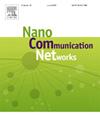Design of an efficient nano-scale configurable digital logic module using coplanar gates for quantum-based communication networks
IF 4.7
4区 计算机科学
Q2 ENGINEERING, ELECTRICAL & ELECTRONIC
引用次数: 0
Abstract
The electronic chip industry is moving toward downsizing, which places physical constraints on complementary metal oxide semiconductor (CMOS) technology. At lower threshold levels, the issues with current leakage and dissipated energy in CMOS have become apparent. As a result, researchers are exploring alternatives that could replace CMOS in the coming years. Quantum dot cellular automata (QCA), a recently created transistor-free structure with tremendous chip density, exceptionally low power consumption, and speedy processing operations, is one of the crucial technologies that can be utilized as a substitute for CMOS technology. The configurable logic module (CLM) is one of the most important digital structures that are useful in FPGA circuits. The previous configurable logic module suffers from a high occupied area and low speed, so it is necessary to solve all the previous shortcomings by implementing it in a suitable technology such as QCA to increase the efficiency of the entire field-programmable gate array (FPGA) circuit. If the programmable circuit is quick, power-conscious, and nano-sized, the effectiveness of high-end complex circuits like the FPGA is considerably increased. In the QCA, configurable systems are not addressed much. The present paper examines the exploration of the conception and implementation of an innovative CLM within the QCA framework, incorporating nano communication networks. A D flip flop, a programmable block (PB), and a multiplexer are used in the construction of the module under examination, which is enhanced with nano communication networks for improved functionality. This module’s durability can be ascribed to the skillful development of both sequential and combinational circuits, combined with the benefits of nano communication networks. The implementation of sophisticated circuits, such as 2-bit, 3-bit, and 4-bit slice designs for FPGA, demonstrates the suggested module’s flexibility and versatility. When compared to an identical circuit that already exists, the QCA-based 4-bit slice circuit that has been recommended has exhibited a considerable improvement in cell count and area. Compared to the best previous coplanar architecture, the suggested 4-bit slice performed 30 % and 40 % better regarding the area and cell count, respectively. In addition, when compared to the best 16-bit LUT design, the suggested structure has produced results that are 14.72 percent and 3.81 percent more effective regarding area and cell count, correspondingly. All the recommended circuits incorporating nano communication networks have been simulated using QCA Designer 2.0.3 technology.
基于共面门的量子通信网络高效纳米级可配置数字逻辑模块设计
电子芯片行业正在走向小型化,这给互补金属氧化物半导体(CMOS)技术带来了物理限制。在较低的阈值水平下,CMOS中的电流泄漏和耗散能量问题变得明显。因此,研究人员正在探索未来几年可能取代CMOS的替代品。量子点元胞自动机(Quantum dot cellular automata, QCA)是最近发明的一种无晶体管结构,具有巨大的芯片密度、极低的功耗和快速的处理操作,是可以用作CMOS技术替代品的关键技术之一。可配置逻辑模块(CLM)是FPGA电路中最重要的数字结构之一。以往的可配置逻辑模块存在占用面积大、速度慢的缺点,因此有必要将其实现在QCA等合适的技术中,以提高整个现场可编程门阵列(FPGA)电路的效率。如果可编程电路是快速的、功耗敏感的和纳米级的,那么像FPGA这样的高端复杂电路的效率就会大大提高。在QCA中,对可配置系统的处理不多。本文探讨了在QCA框架内结合纳米通信网络的创新CLM的概念和实施的探索。D触发器、可编程块(PB)和多路复用器用于测试模块的构建,并通过纳米通信网络增强功能。该模块的耐用性可归因于顺序电路和组合电路的熟练开发,以及纳米通信网络的优势。复杂电路的实现,如FPGA的2位、3位和4位切片设计,证明了所建议模块的灵活性和通用性。与已经存在的相同电路相比,推荐的基于qca的4位切片电路在细胞计数和面积方面表现出相当大的改进。与之前最好的共面架构相比,建议的4位切片在面积和细胞计数方面分别提高了30%和40%。此外,与最佳的16位LUT设计相比,所建议的结构在面积和细胞计数方面的效率分别提高了14.72%和3.81%。采用QCA Designer 2.0.3技术对所有推荐的集成纳米通信网络的电路进行了仿真。
本文章由计算机程序翻译,如有差异,请以英文原文为准。
求助全文
约1分钟内获得全文
求助全文
来源期刊

Nano Communication Networks
Mathematics-Applied Mathematics
CiteScore
6.00
自引率
6.90%
发文量
14
期刊介绍:
The Nano Communication Networks Journal is an international, archival and multi-disciplinary journal providing a publication vehicle for complete coverage of all topics of interest to those involved in all aspects of nanoscale communication and networking. Theoretical research contributions presenting new techniques, concepts or analyses; applied contributions reporting on experiences and experiments; and tutorial and survey manuscripts are published.
Nano Communication Networks is a part of the COMNET (Computer Networks) family of journals within Elsevier. The family of journals covers all aspects of networking except nanonetworking, which is the scope of this journal.
 求助内容:
求助内容: 应助结果提醒方式:
应助结果提醒方式:


